If you are making prints on tracing paper, labels, transparencies, or nonstandard paper size stock, load the paper stock into the multi-purpose tray.
|
IMPORTANT
|
|
Note the following points when using the multi-purpose tray:
Paper Quantity: one to approximately 100 sheets (80 g/m2), stack approximately 10 mm high
Paper Size: 100 mm × 148 mm to 139.6 mm × 487.7 mm, 139.7 mm × 148 mm to 297 mm × 487.7 mm
Paper Weight: 52 to 256 g/m2
Paper which has been rolled or curled must be straightened out prior to use, to allow the paper to feed smoothly through the multi-purpose tray (allowable curl amount: less than 10 mm for normal paper, less than 5 mm for heavy paper). There are some types of paper stock, which may meet the above specifications, but cannot be fed into the multi-purpose tray.
Fan the stack of paper well before loading it. Paper such as thin paper, recycled paper, pre-punched paper, heavy paper, labels, and transparencies should be fanned particularly well before loading it.
Do not load different size/type paper at the same time.
Feed tracing paper one sheet at a time, and remove each sheet as it is delivered to the output tray. Loading several sheets of tracing paper together may cause paper jams.
Depending on the type of heavy paper you want to load, if you load multiple sheets of heavy paper into the multi-purpose tray, a paper jam may occur. In this case, load only one sheet of heavy paper at a time.
If you are making two-sided prints, select the 2-Sided mode. The printed paper may crease depending on the moisture absorption condition of the paper, and if you copy the two pages as two one-sided documents.
To print on the backside of preprinted paper, load the paper into the multi-purpose tray, and press [2nd Side of 2-Sided Page] on the paper selection screen that appears.
When printing on special types of paper, such as heavy paper or transparencies, be sure to correctly set the paper type, especially if you are using heavy paper. If the type of paper is not set correctly, it could adversely affect the quality of the image. Moreover, the fixing unit may become dirty and require a service repair, or the paper could jam.
|
|
NOTE
|
|
When scanning the following originals, you cannot use the Automatic Paper Selection mode. Use the Manual Paper Selection mode when scanning these types of originals:
Highly transparent originals, such as transparencies
Originals with an extremely dark background
For high-quality printouts, use paper recommended by Canon.
When loading transparencies into the multi-purpose tray, see "Loading Transparencies."
|
You can select standard inch paper, or A or B series paper.
You can load nonstandard paper sizes (100 mm x 148 mm to 297 mm x 487.7 mm).
You can load nonstandard paper sizes (100 mm × 148 mm to 297 mm × 487.7 mm).
1.
Open the multi-purpose tray.
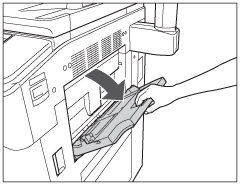
|
NOTE
|
|
If the paper size you are going to load into the multi-purpose tray is different from the paper size stored in Register Multi-Purpose Tray Defaults, set Register Multi-Purpose Tray Defaults to 'Off' in Preferences (from the Settings/Registration screen). (See "Registering Multi-Purpose Tray Defaults.")
|
Press [Select Paper] → [MP Tray] → select the paper size and type loaded in the multi-purpose tray.
Proceed to step 6.
Check to see if any job is reserved. (See "Checking and Cancelling the Copy/Print Jobs.")
If there is a current or reserved job, you can reserve a change of paper for the multi-purpose tray. (See "Using the Multi-Purpose Tray" and "Reserving Jobs.")
If there is no reserved job, remove any paper remaining in the multi-purpose tray → continue the procedure from step 2.
2.
Adjust the slide guides to match the size of the paper.
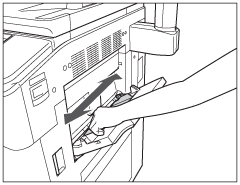
If you are feeding large size paper, pull out the auxiliary tray.
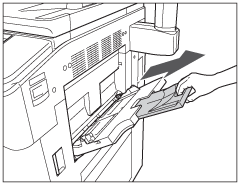
3.
Load the paper into the multi-purpose tray.

Make sure that the height of the paper stack does not exceed the loading limit mark ( ).
).
 ).
).When you use the multi-purpose tray to make copies, straighten out curled papers prior to use, as shown below. Curled paper may cause a paper jam.
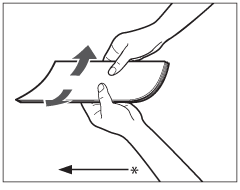
* Feeding Direction
To print on the backside of preprinted paper, load the blank side of the preprinted paper face up into the multi-purpose tray, as shown in the illustration below.
|
After the first one-sided copy
is made |
When copying on the backside
of a preprinted sheet |
|
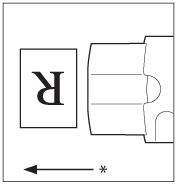 |
 |
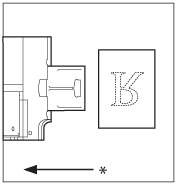 |
|
* Output Direction
|
* Feeding Direction
|
|
IMPORTANT
|
|
When loading paper into the multi-purpose tray, align the paper stack neatly between the slide guides. If the paper is not loaded correctly, a paper jam may occur.
When loading paper into the multi-purpose tray, make sure that the paper is placed down flat. The paper may not be able to be fed if the slide guides are set to a size smaller than the paper, causing it to curve up.
|
|
NOTE
|
|
If there are instructions on the paper package about which side of the paper to load, follow those instructions.
When the paper is loaded into the multi-purpose tray, the side facing up is the one printed on.
If problems, such as poor print quality or paper jams occur, try turning the paper stack over and reload it.
For more information on the print direction of preprinted paper (paper which has logos or patterns already printed on it), see Chapter 17, "Appendix," in Getting Started.
|
|
NOTE
|
|
If there are instructions on the paper package about which side of the paper to load, follow those instructions.
When the paper is loaded into the multi-purpose tray, the side facing up is the one printed on.
If problems, such as poor print quality or paper jams occur, try turning the paper stack over and reload it.
For more information on the print direction of preprinted paper (paper which has logos or patterns already printed on it), see Chapter 16, "Appendix," in Getting Started.
|
4.
Select the desired paper size.
Select the desired paper size → press [Next].
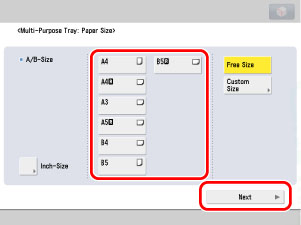
|
NOTE
|
|
To select an inch series paper size, press [Inch-Size].
|
Press [Free Size] → [Next].
Press [Custom Size].
Enter the size of the paper using the numeric keys on the touch panel display.
Press [X] → enter a value.
Press [Y] → enter a value.
Press [OK].
You can also select a size key ([S1] to [S5]) containing a stored paper size setting, instead of entering values.
|
NOTE
|
|
If you make a mistake when entering values, press [C] on the touch panel display → enter the correct values.
To select a registered paper size stored in a size key ([S1] to [S5]), you must store the irregular paper size in the size key beforehand. For instructions on storing irregular paper sizes, see "Registering and Editing Custom Paper Sizes."
|
Press [Next].
5.
Select the desired paper type → press [OK].
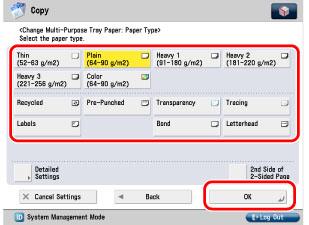
If you are using a paper type that is not listed, press [Detailed Settings] → select the paper type → press [OK].
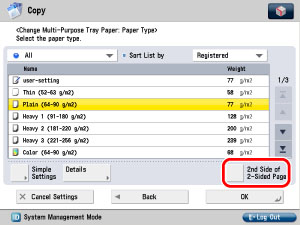
If you are printing on the backside of a previously printed sheet, press [2nd Side of 2-Sided Page].
|
NOTE
|
|
[Transparency] can be selected only if [A4] or [A4R] is selected as the paper size.
For more information on paper types, see "Available Paper Stock."
You can register a paper type that is not listed in [Detailed Settings] in the Multi-Purpose Tray Settings: Selecting the Paper Type screen. For details on registering paper types, see "Registering/Editing Custom Paper Types."
|
6.
Press [OK].
If you press [Change MP Tray Paper], follow the procedures and screens in steps 4 and 5 to reset the paper size and type settings.
7.
If the Copy function is selected, place your originals → select the desired copy settings.
If you are printing documents that are stored in the Fax/I-Fax Inbox and the data storage in this device, this step is not necessary.
8.
Press  .
.
 .
.If you are printing documents that are stored in the Fax/I-Fax Inbox and the data storage in this device, press [Start Printing].
Copying or scanning starts.
|
NOTE
|
|
To cancel all settings and return the machine to the Standard mode, press
 . . |